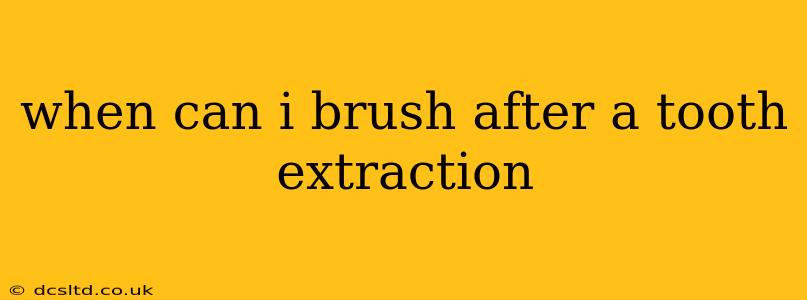When Can I Brush After a Tooth Extraction?
The question of when you can brush after a tooth extraction is a common one, and the answer isn't a simple "24 hours" or similar. The timing depends heavily on the specifics of your extraction and your dentist's instructions. Ignoring these instructions could lead to complications like dry socket, infection, or delayed healing. Always prioritize your dentist's advice.
What Happens Immediately After an Extraction?
Following a tooth extraction, a blood clot forms in the socket where the tooth was removed. This clot is crucial for healing; it protects the bone and nerves, prevents infection, and promotes healthy tissue regeneration. Disturbing this clot prematurely can lead to a painful and potentially serious complication called dry socket (alveolar osteitis).
How Long Should I Wait Before Brushing?
Generally, dentists recommend waiting at least 24 hours before brushing near the extraction site. However, this is a guideline, not a hard and fast rule. Some extractions, particularly those involving more complex procedures or impacted teeth, may require a longer waiting period. Your dentist will provide specific instructions tailored to your individual case.
What Can I Do in the First 24 Hours?
During the initial 24 hours, focus on gently rinsing your mouth with salt water (a half-teaspoon of salt dissolved in a glass of warm water). This helps keep the area clean and promotes healing. Avoid vigorous rinsing or spitting, as this can dislodge the blood clot. You can brush the rest of your teeth gently, but avoid the extraction site.
How Should I Brush After 24 Hours?
After the 24-hour period (or as instructed by your dentist), you can resume brushing your teeth, including the area near the extraction site. However, be incredibly gentle! Use a soft-bristled toothbrush and avoid scrubbing aggressively. Direct the brush away from the extraction site to prevent disrupting the healing process.
What if I Develop Dry Socket?
Dry socket is characterized by intense pain, a bad odor, and sometimes a visible empty socket. If you experience these symptoms, contact your dentist immediately. They can provide pain relief and treatment to help the socket heal properly.
What Kind of Toothbrush Should I Use?
A soft-bristled toothbrush is recommended, both before and after the extraction, to minimize the risk of irritation and damage to the gums and healing socket.
Can I Use Mouthwash After a Tooth Extraction?
Generally, it's best to avoid mouthwash, especially alcohol-based ones, for the first few days after an extraction. These can irritate the extraction site and potentially delay healing. Your dentist may recommend a specific mouthwash if needed.
Should I Use an Electric Toothbrush After Extraction?
While you can use an electric toothbrush after the initial 24-hour period, it’s crucial to use a soft brush head and maintain extra gentleness around the extraction site. Some people find manual brushing easier to control in this situation.
When Can I Resume Normal Brushing?
Full healing takes several weeks, so even after the initial 24-hour period, continue to be gentle when brushing near the extraction site for several weeks until complete healing is observed.
In summary: Always follow your dentist's specific post-extraction instructions. While a 24-hour waiting period is a common guideline for brushing near the extraction site, individual circumstances may require adjustments. Gentle brushing, soft-bristled toothbrushes, and careful rinsing are crucial for optimal healing.
